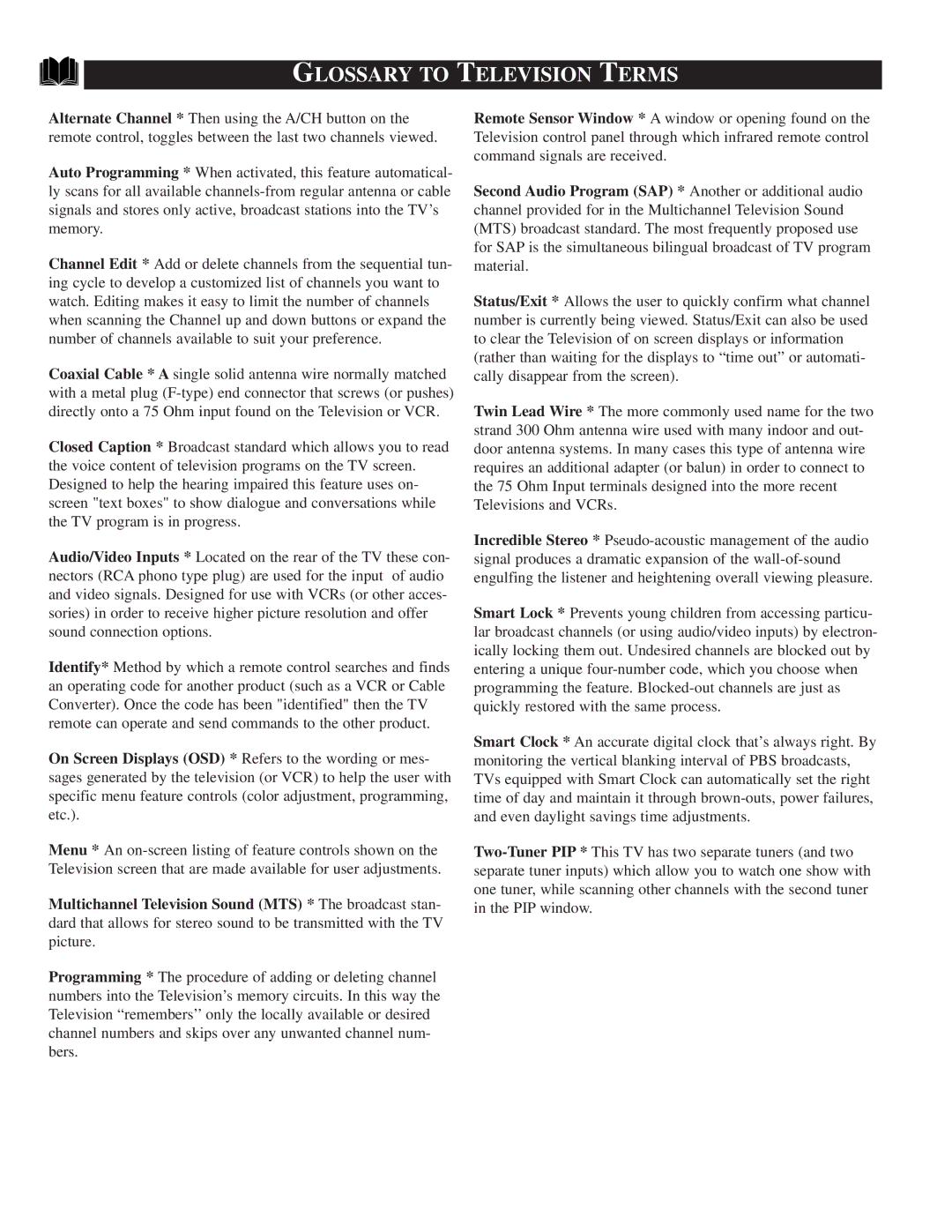GLOSSARY TO TELEVISION TERMS
Alternate Channel * Then using the A/CH button on the remote control, toggles between the last two channels viewed.
Auto Programming * When activated, this feature automatical- ly scans for all available
Channel Edit * Add or delete channels from the sequential tun- ing cycle to develop a customized list of channels you want to watch. Editing makes it easy to limit the number of channels when scanning the Channel up and down buttons or expand the number of channels available to suit your preference.
Coaxial Cable * A single solid antenna wire normally matched with a metal plug
Closed Caption * Broadcast standard which allows you to read the voice content of television programs on the TV screen. Designed to help the hearing impaired this feature uses on- screen "text boxes" to show dialogue and conversations while the TV program is in progress.
Audio/Video Inputs * Located on the rear of the TV these con- nectors (RCA phono type plug) are used for the input of audio and video signals. Designed for use with VCRs (or other acces- sories) in order to receive higher picture resolution and offer sound connection options.
Identify* Method by which a remote control searches and finds an operating code for another product (such as a VCR or Cable Converter). Once the code has been "identified" then the TV remote can operate and send commands to the other product.
On Screen Displays (OSD) * Refers to the wording or mes- sages generated by the television (or VCR) to help the user with specific menu feature controls (color adjustment, programming, etc.).
Menu * An
Multichannel Television Sound (MTS) * The broadcast stan- dard that allows for stereo sound to be transmitted with the TV picture.
Programming * The procedure of adding or deleting channel numbers into the Television’s memory circuits. In this way the Television “remembers’’ only the locally available or desired channel numbers and skips over any unwanted channel num- bers.
Remote Sensor Window * A window or opening found on the Television control panel through which infrared remote control command signals are received.
Second Audio Program (SAP) * Another or additional audio channel provided for in the Multichannel Television Sound (MTS) broadcast standard. The most frequently proposed use for SAP is the simultaneous bilingual broadcast of TV program material.
Status/Exit * Allows the user to quickly confirm what channel number is currently being viewed. Status/Exit can also be used to clear the Television of on screen displays or information (rather than waiting for the displays to “time out” or automati- cally disappear from the screen).
Twin Lead Wire * The more commonly used name for the two strand 300 Ohm antenna wire used with many indoor and out- door antenna systems. In many cases this type of antenna wire requires an additional adapter (or balun) in order to connect to the 75 Ohm Input terminals designed into the more recent Televisions and VCRs.
Incredible Stereo *
Smart Lock * Prevents young children from accessing particu- lar broadcast channels (or using audio/video inputs) by electron- ically locking them out. Undesired channels are blocked out by entering a unique
Smart Clock * An accurate digital clock that’s always right. By monitoring the vertical blanking interval of PBS broadcasts, TVs equipped with Smart Clock can automatically set the right time of day and maintain it through
